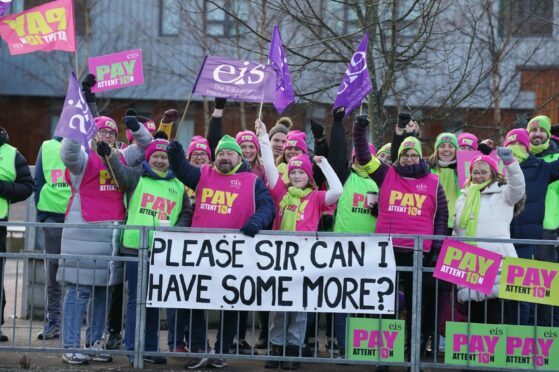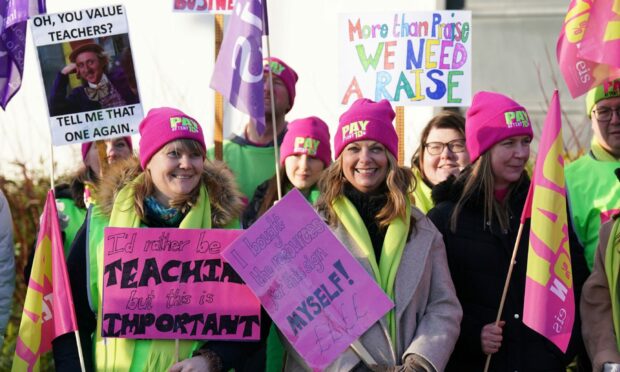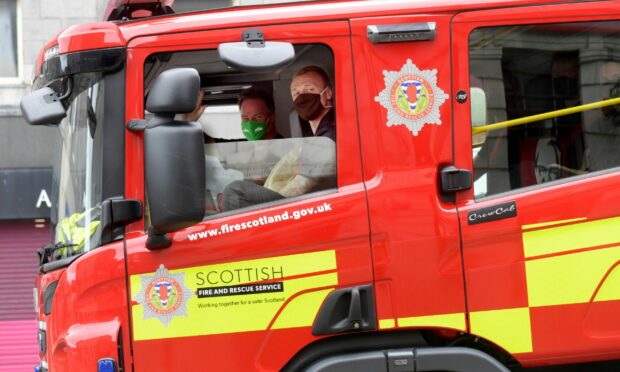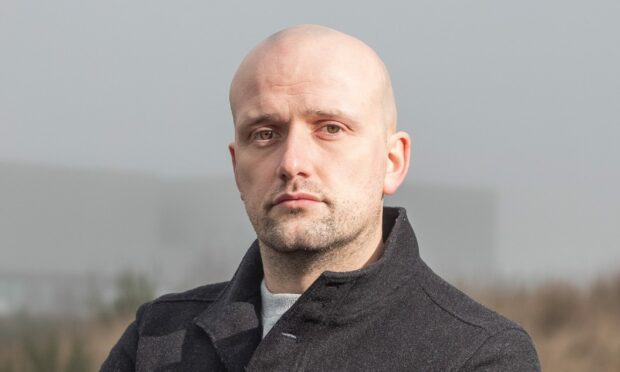Widespread industrial action has disrupted nearly every public service in Scotland, including our schools, emergency services and transport.
It has also hit the Scottish Parliament where some MSPs refused to cross a picket line on the day an estimated 500,000 UK workers walked out.
Here’s a guide to why people are striking, what their unions demand and where communities across the country are feeling the impact.
Schools
Teachers have been taking turns to strike in different areas in recent weeks as the EIS union fights for better pay and conditions.
Staff in Perth and Kinross led the way with a strike on January 17, while Fife staff took industrial action the following day.
Angus teachers went on strike on January 20, while staff in Dundee agreed to stay home on February 2.
Two days of national strikes will follow on February 28 and March 1 if their demands are not met.
If the row continues after that, staff will take part in a rolling programme of walkouts across Scotland’s 32 council areas from March 13 to April 21.
The EIS want teachers across Scotland to get a 10% pay increase.
Scottish Government education secretary Shirley Anne-Somerville offered staff a 5% rise, saying it would take wages for a fully-qualified teacher to more than £35,000.
Other demands from the EIS include increasing teacher numbers, reducing class contact time for staff and bringing down class sizes.
Firefighters
For the first time in 20 years, firefighters across Scotland voted for industrial action in a pay dispute.
The Fire Brigades Union (FBU) rejected a 5% wage rise offer with the vast majority of their members backing a strike on January 31.
The Scottish Fire and Rescue Service says there will still be firefighters available to attend any incidents during industrial action.
No dates for the strikes have been announced yet. Union bosses are still to meet employers, and say they want a pay rise which is above the rate of inflation.
Nurses
First Minister Nicola Sturgeon and Health Secretary Humza Yousaf were able to avert an NHS strike last month when nurses threatened to walk out.
The Royal College of Nursing announced it would pause planned industrial action after the government agreed to discuss a wage increase.
By contrast, nurses and ambulance workers walked out last month in England and are set to strike again on February 6 as their dispute with Westminster continues.
Universities
University and college staff across the Scotland went on strike on February 1, meaning some students in Dundee and St Andrews saw lectures cancelled.
Further industrial action will follow on a further 10 days from February 9 to February 28, and on seven dates next month from March 1 to March 22.
The Universities and Colleges Union wants employers to improve on a pay offer at the moment of up to 5%.
Union chiefs also claim current plans will see academic staff losing out on key pension benefits, which they want to see restored.
They claim cuts will see staff lose out on 35% of their future retirement income, and warn this will top £100,000 for staff starting out in their careers.
Railways
Scotland was crippled by rail strikes throughout much of 2022.
Walkouts spearheaded by the RMT and Aslef unions meant some cross-border services to England were off on February 3, but ScotRail services continued to run as normal.
Rail bosses at ScotRail were able to reach an agreement with trade union chiefs in November to raise wages for workers by at least 7.5% and guarantee no compulsory redundancies for at least six years.
But separate disputes involving the RMT union and Network Rail over proposed job cuts mean future strike action may continue to impact Scotland.
Postal workers
Postal workers across Scotland are set to take industrial action for a full 24 hours later this month from 12.30pm on February.
The Communication Workers Union (CWU) have been locked in a long-running dispute with Royal Mail over plans for making workers redundant.
The union – which represents 115,000 people across the UK – have claimed Royal Mail bosses are “hell-bent on ripping up historic arrangements” to protect workers’ rights.
In October 2022, they rejected a 7% pay increase offer over two years which came with an additional 2% lump sum payment.
Civil servants
The Scottish Parliament was quiet on February 1 as many civil servants walked out and picketed Holyrood.
Civil servants want a 10% pay increase, but up until now they have only been offered a 2% rise.
UK Government statistics from March 2022 showed the average civil servant in Scotland earns just under £28,000 a year.
Senior staff can earn over £80,000 per annum, while administrative workers typically bring in just above £21,000.
Labour and Scottish Green MSPs decided not to enter parliament in a show of support to those fighting for higher pay.
The PCS union, representing government workers, has also warned more than 90,000 staff are at risk of redundancy due to planned Westminster job cuts.
How are the Scottish and UK governments responding?
The SNP Government says it has limited funds to give public sector staff the wage increases being demanded due to inflation pressures on budgets.
In an emergency budget in Holyrood last November, Deputy First Minister John Swinney said cuts would be needed to meet any pay increases.
However, the SNP has widely condemned Tory plans to curb the ability of key workers in vital public sector jobs to take industrial action.
The SNP’s Westminster leader, Dundee-born Stephen Flynn, said: “The SNP will always stand up for workers’ rights and vigorously defend the right to strike.”
Rishi Sunak has blamed trade unions for strikes across the UK and has regularly used industrial action to attack his Labour rival Sir Keir Starmer.
At Prime Minister’s Questions on February 1 he said: “He can’t stand up to his union bosses. He can’t stand up for Britain’s schoolchildren today.”






Conversation